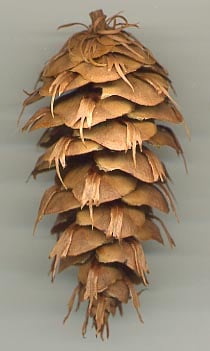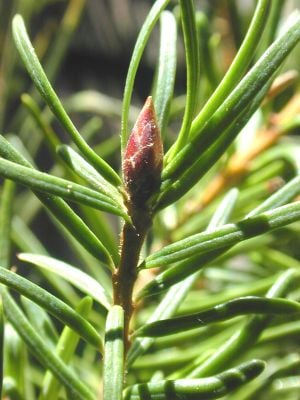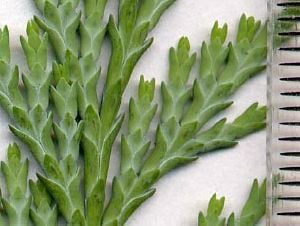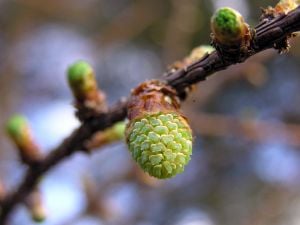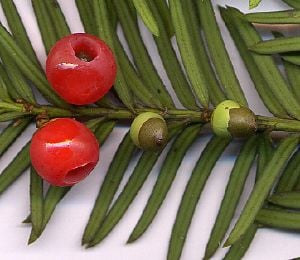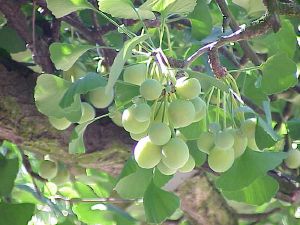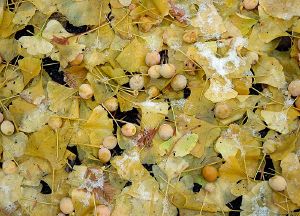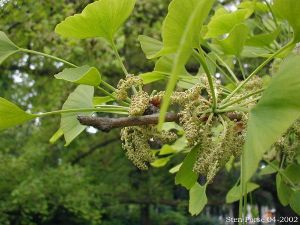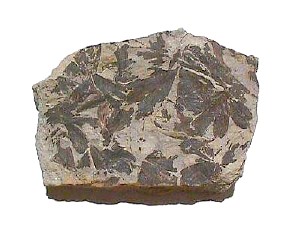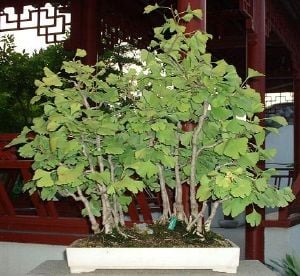Difference between revisions of "Gymnosperm" - New World Encyclopedia
Rick Swarts (talk | contribs) |
Miriam Jones (talk | contribs) |
||
| Line 22: | Line 22: | ||
==Pinophyta== | ==Pinophyta== | ||
| − | '' | + | The '''conifers''', division '''Pinophyta''', also known as division '''Coniferae''', are one of 13 or 14 [[division (botany)|division]] level taxa within the [[Plant|Kingdom Plantae]]. They are cone-bearing seed [[plant]]s with vascular tissue; all extant conifers are woody plants, the great majority being [[tree]]s with just a few being shrubs. Typical examples of conifers include cedars, cypresses, douglas-firs, firs, junipers, kauris, larches, pines, redwoods, spruces, and yews. Species of conifers can be found growing naturally in almost all parts of the world, and are frequently dominant plants in their habitats, as in e.g. the taiga. Conifers are of immense economic value, primarily for timber and paper production; the wood of conifers is known as softwood. |
| − | + | ===Taxonomy and naming=== | |
| + | The division name Pinophyta conforms with the rules of the ''ICBN'', which state (Art 16.1) that the names of higher taxa in [[plant]]s (above the rank of family) are either formed from the name of an included family, in this case Pinaceae (the pine family), or are descriptive. In the latter case the name for the conifers (at whatever rank is chosen) is '''Coniferae''' (Art 16 Ex 2), which is also in widespread use. Older scientific names (no longer allowed) are Coniferophyta and Coniferales. | ||
| + | |||
| + | Commonly but erroneously, conifers are considered equivalent to the Gymnosperms, as in areas with a temperate climate conifers are often the only commonly occurring gymnosperms. However, these are two quite different groupings; conifers are the largest and economically most important component group of the gymnosperms, but nevertheless only one of the four component groups. It is not clear if gymnosperms are a natural group; it may well be polyphyletic as the component groups like the [[cycad]]s and [[ginkgo]]s are quite distinct plants (see diagram below), though some recent research does indicate they may be monophyletic. | ||
| + | |||
| + | The division Pinophyta consists of just one class, Pinopsida, which includes both living and fossil taxa. Subdivision of the living conifers into two or more orders has been proposed from time to time. The most commonly seen in the past was a split into two orders, Taxales (Taxaceae only) and Pinales (the rest), but recent research into [[DNA]] sequences suggests that this interpretation leaves the Pinales without Taxales as paraphyletic, and the latter order is no longer regarded as distinct. A more accurate subdivision would be to split the class into three orders, Pinales containing only Pinaceae, Araucariales containing Araucariaceae and Podocarpaceae, and Cupressales containing the remaining families (including Taxaceae), but there has not been any significant support for such a split, with the majority of opinion preferring retention of all the families within a single order Pinales, despite their antiquity and diverse morphology. | ||
| + | |||
| + | [[Image:Pinophyta.png|left|thumb|380px|Phylogeny of the Pinophyta based on [[cladistic]] analysis of [[molecular biology|molecular data]]. Derived from papers by A. Farjon and C. J. Quinn & R. A. Price in the Proceedings of the Fourth International Conifer Conference, ''Acta Horticulturae'' 615 (2003)]] | ||
| + | The conifers are now accepted as comprising six to eight families, with a total of 65-70 genera and 600-650 species. The seven most distinct families are linked in the box above right and phylogenetic diagram left. In other interpretations, the Cephalotaxaceae may be better included within the Taxaceae, and some authors additionally recognise Phyllocladaceae as distinct from Podocarpaceae (in which it is included here). The family Taxodiaceae is here included in family Cupressaceae, but was widely recognised in the past and can still be found in many field guides. | ||
| + | |||
| + | The conifers are an ancient group, with a [[fossil]] record extending back about 300 million years to the Paleozoic in the late [[Carboniferous]] period; even many of the modern genera are recognisable from fossils 60-120 million years old. Other classes and orders, now long extinct, also occur as fossils, particularly from the late Paleozoic and [[Mesozoic]] eras. Fossil conifers included many diverse forms, the most dramatically distinct from modern conifers being some herbaceous conifers with no woody stems. Major fossil orders of conifers or conifer-like plants include the Cordaitales, Vojnovskyales, Voltziales and perhaps also the Czekanowskiales (possibly more closely related to the Ginkgophyta). <br clear = left> | ||
| + | |||
| + | ===Morphology=== | ||
| + | All living conifers are woody plants, and most are trees, the majority having monopodial growth form (a single, straight trunk with side branches) with strong apical dominance. The size of mature conifers varies from less than one metre, to over 100 metres. The world's tallest, largest, thickest and oldest living things are all conifers. The tallest is a Coast Redwood (''Sequoia sempervirens''), with a height of 112.83 metres. The largest is a Giant Sequoia (''Sequoiadendron giganteum''), with a volume 1486.9 cubic metres. The thickest, or tree with the greatest trunk diameter, is a Montezuma Cypress (''Taxodium mucronatum''), 11.42 metres in diameter. The oldest is a Great Basin Bristlecone Pine (''Pinus longaeva''), 4,700 years old. | ||
| + | |||
| + | ===Foliage=== | ||
| + | [[Image:Douglas_fir_leaves_and_bud.jpg|left|thumb|Pinaceae: needle leaves and bud of Coast Douglas-fir (''Pseudotsuga menziesii'')]] | ||
| + | [[Image:C lawsoniana Lge.jpg|right|thumb|[[Cupressaceae]]: scale leaves of Lawson's Cypress (''Chamaecyparis lawsoniana''); scale in mm]] | ||
| + | The [[leaf|leaves]] of many conifers are long, thin and needle-like, but others, including most of the Cupressaceae and some of the Podocarpaceae, have flat, triangular scale-like leaves. Some, notably ''Agathis'' in Araucariaceae and ''Nageia'' in Podocarpaceae, have broad, flat strap-shaped leaves. In the majority of conifers, the leaves are arranged spirally, exceptions being most of Cupressaceae and one genus in Podocarpaceae, where they are arranged in decussate opposite pairs or whorls of 3 (-4). In many [[species]] with spirally arranged leaves, the leaf bases are twisted to present the leaves in a flat plane for maximum [[light]] capture (see e.g. photo of Grand Fir ''Abies grandis''). [[Leaf]] size varies from 2 mm in many scale-leaved species, up to 400 mm long in the needles of some pines (e.g. Apache Pine ''Pinus engelmannii''). The stomata are in lines or patches on the leaves, and can be closed when it is very dry or cold. The leaves are often dark green in colour which may help absorb a maximum of energy from weak sunshine at high latitudes or under forest canopy shade. Conifers from hotter areas with high sunlight levels (e.g. Turkish Pine ''Pinus brutia'') often have yellower-green leaves, while others (e.g. Blue Spruce ''Picea pungens'') have a very strong glaucous wax bloom to reflect ultraviolet light. In the great majority of genera the leaves are evergreen, usually remaining on the plant for several (2-40) years before falling, but five genera (''Larix'', ''Pseudolarix'', ''Glyptostrobus'', ''Metasequoia'' and ''Taxodium'') are deciduous, shedding the [[leaf|leaves]] in autumn and leafless through the winter. The seedlings of many conifers, including most of the Cupressaceae, and ''Pinus'' in Pinaceae, have a distinct juvenile foliage period where the leaves are different, often markedly so, from the typical adult leaves. | ||
| + | |||
| + | ====Reproduction==== | ||
| + | [[image:largepinecone.jpg|right|thumb|Pinaceae: cone of a Norway Spruce (''Picea abies'')]] | ||
| + | [[Image:Immature_fir_cone.jpg|thumb|right|Pinaceae: pollen cone of a Japanese Larch (''Larix kaempferi'')]] | ||
| + | ''See conifer cones for a more detailed discussion.'' | ||
| + | |||
| + | Most conifers are monoecious, but some are subdioecious or dioecious; all are wind-pollinated. Conifer seeds develop inside a protective cone called a ''strobilus'' (or, very loosely, "pine cones", which technically occur only on pines, not other conifers!). The cones take from four months to three years to reach maturity, and vary in size from 2 mm to 600 mm long. | ||
| + | In Pinaceae, Araucariaceae, Sciadopityaceae and most Cupressaceae, the cones are woody, and when mature the scales usually spread open allowing the seeds to fall out and be dispersed by the wind. In some (e.g. firs and cedars), the cones disintegrate to release the seeds, and in others (e.g. the pines that produce pine nuts) the nut-like seeds are dispersed by [[bird]]s (mainly nutcrackers and jays) which break up the specially adapted softer cones. Ripe cones may remain on the [[plant]] for a varied amount of time before falling to the ground; in some fire-adapted pines, the seeds may be stored in closed cones for up to 60-80 years, being released only when a fire kills the parent [[tree]]. | ||
| + | |||
| + | [[Image:TXbaccata.jpg|left|thumb|Taxaceae: the fleshy aril which surrounds each seed in the European Yew (''Taxus baccata'') is a highly modified seed cone scale]] | ||
| + | In the families Podocarpaceae, Cephalotaxaceae, Taxaceae, and one Cupressaceae genus (''Juniperus''), the scales are soft, fleshy, sweet and brightly coloured, and are eaten by fruit-eating birds, which then pass the [[seed]]s in their droppings. These fleshy scales are (except in ''Juniperus'') known as arils. In some of these conifers (e.g. most Podocarpaceae), the cone consists of several fused scales, while in others (e.g. Taxaceae), the cone is reduced to just one seed scale or (e.g. Cephalotaxaceae) the several scales of a cone develop into individual arils, giving the appearance of a cluster of berries. | ||
| + | |||
| + | The male cones have structures called microsporangia which produce yellowish [[pollen]]. Pollen is released and carried by the wind to female cones. Pollen grains from living pinophyte species produce pollen tubes, much like those of angiosperms. When a [[pollen]] grain lands near a female gametophyte, it undergoes meiosis and fertilizes the female gametophyte. The resulting zygote develops into an embryo, which along with its surrounding integument, becomes a [[seed]]. Eventually the seed may fall to the ground and, if conditions permit, grows into a new plant. | ||
| + | |||
| + | In forestry, the terminology of flowering plants has commonly though inaccurately been applied to cone-bearing trees as well. The male cone and unfertilized female cone are called "male flower" and "female flower", respectively. After fertilization, the female cone is termed "fruit", which undergoes "ripening" (maturation). | ||
| + | |||
| + | ====Life cycle==== | ||
| + | # To fertilize the ovum, the male cone releases [[pollen]] that is carried on the wind to the female cone. | ||
| + | # A fertilized female gamete (called a zygote) develops into an embryo. | ||
| + | # Along with integument cells surrounding the embryo, a [[seed]] develops containing the embryo. | ||
| + | # Mature seed drops out of cone onto the ground. | ||
| + | # Seed germinates and seedling grows into a mature plant. | ||
| + | # When mature, the adult plant produces cones. | ||
| + | |||
| + | ===Other facts=== | ||
| + | [[image:Young_pine_trees_sm.jpg|left|thumb|Young [[Longleaf Pine]] trees]] | ||
| + | Although the total number of species is relatively small, conifers are of immense [[ecology|ecological]] importance. They are the dominant plants over huge areas of land, most notably the boreal forests of the northern hemisphere, but also in similar cool climates in mountains further south. | ||
| + | |||
| + | Many conifers have distinctly scented resin, secreted to protect the [[tree]] against [[insect]] infestation and [[fungus|fungal]] infection of wounds. Fossilised resin hardens into amber. | ||
==Ginkgo== | ==Ginkgo== | ||
| − | '' | + | The '''Ginkgo''' ('''''Ginkgo biloba'''''), frequently misspelled as "Gingko", and sometimes known as the '''Maidenhair Tree''', is a unique [[tree]] with no close living relatives. It is classified in its own division, the '''Ginkgophyta''', comprising the single class '''Ginkgoopsida''', order '''Ginkgoales''', family '''Ginkgoaceae''', genus '''''Ginkgo''''' and just the one species. It is one of the best known examples of a [[living fossil]]. In the past it has also been placed in the divisions [[Spermatophyta]] or [[Pinophyta]]. Ginkgo is a [[gymnosperm]] (as opposed to an [[angiosperm]]), meaning "naked seed"; its seeds are not protected by an [[ovary]] wall and hence, the berry-like structures produced by female ginkgo trees are technically not [[fruit]]. |
| + | |||
| + | For centuries it was thought to be extinct in the wild, but is now known to grow wild in at least two small areas in [[Zhejiang]] province in eastern [[China]], in the [[Tian Mu Shan Reserve]]. However, as this area has known human activity for over a thousand years, the wild status of ginkgos there is as yet uncertain. | ||
| + | |||
| + | ==Characteristics== | ||
| + | [[Image:Ginkgo biloba0.jpg|left|thumb|Ginkgo seeds and leaves]] | ||
| + | ===Habit=== | ||
| + | Ginkgos are medium-large [[deciduous]] trees, reaching 20–35 m tall (some specimens in China being over 50 m), with an often angular crown and long, somewhat erratic branches. They are usually deep rooted and resistant to wind and snow damage. Young trees are often tall and slender, and sparsely branched; the crown becomes broader as the tree ages. During autumn, the leaves turn a bright yellow, then fall, sometimes within a short space of time (1–15 days). A combination of amazing disease resistance, insect-resistant wood and the ability to form aerial roots and sprouts means that ginkgos are very long-lived, with some specimens claimed to be more than 2,500 years old; a 3,000 year-old gingko is reported in Shandong province in China (Lewington and Parker, 183). | ||
| + | |||
| + | Some old Ginkgos produce aerial roots, known as ''chichi'' (Japanese; "[[nipple]]s") or ''zhong-ru'' (Chinese), which form on the undersides of large branches and grow downwards. Chichi growth is very slow, and may take hundreds of years to occur. The function, if any, of these thick aerial roots is unknown. | ||
| + | |||
| + | ===Stem=== | ||
| + | [[Image:Gingko biloba3.jpg|left|thumb|Ginkgo mature seeds and autumn leaf colour]] | ||
| + | Ginkgo branches grow in length by growth of shoots with regularly spaced leaves, as seen on most trees. From the [[axil]]s of these leaves, "spur shoots" (also known as short shoots) develop on second-year growth. Short shoots have very short internodes (so that several years' growth may only extend them by a centimeter or two) and their leaves are ordinarily unlobed. They are short and knobby, and are arranged regularly on the branches except on first-year growth. Because of the short internodes, leaves appear to be clustered at the tips of short shoots, and reproductive structures are formed only on them (see picture to above left—seeds and leaves can be viewed on short shoots). In Ginkgos, as in other plants that possess them, short shoots allow the formation of new leaves in the older parts of the crown. After a number of years, a short shoot may change into a long (ordinary) shoot, or vice versa. | ||
| + | |||
| + | ===Leaves=== | ||
| + | [[Image:Ginkgo leaf closeup.jpg|100px|thumb|right|A closeup of a Ginkgo leaf]] | ||
| + | |||
| + | The [[leaf|leaves]] are unique among seed plants, being fan-shaped with veins radiating out into the leaf blade, sometimes bifurcating (splitting) but never anastomosing to form a network. Two veins enter the leaf blade at the base and fork repeatedy in two; this is known as dichotomous venation. The leaves are 5-10 cm (rarely to 15 cm) long. The old popular name "Maidenhair tree" is because the leaves resemble some of the pinnae of the [[Maidenhair fern]] ''Adiantum capillus-veneris''. | ||
| + | |||
| + | Leaves of long shoots are usually notched or lobed, but only from the outer surface, between the veins. They are borne both on the more rapidly-growing branch tips, where they are alternate and spaced out, and also on the short, stubby spur shoots, where they are clustered at the tips. During summer the leaves are a deep green, turning to brilliant yellow in the fall. They generally remain yellow for a time, then suddenly drop most of their leaves in what can seem like overnight. | ||
| − | + | ===Reproduction=== | |
| + | [[Image:Gingko_fg01.jpg|thumb|left|autumn leaves and seeds]] | ||
| + | Ginkgos are [[plant sexuality|dioecious]], with separate sexes, some trees being [[female]] and others being [[male]]. Male plants produce small [[conifer cone|pollen cones]] with [[sporophyll]]s each bearing two [[microsporangium|microsporangia]] spirally arranged around a central axis. | ||
| + | [[Image:Ginkgo-biloba-male.JPG|right|thumb|Ginkgo pollen cones]] | ||
| + | Female plants do not produce cones. Two [[ovule]]s are formed at the end of a stalk, and after [[pollination]], one or both develop into seeds. The seed is 1.5-2 cm long. Its outer layer (the [[sarcotesta]]) is light yellow-brown, soft, and [[fruit]]-like. | ||
| + | It is plum-like and attractive, but the seedcoat contains [[butanoic acid]] and smells like rancid [[butter]] (which contains the same chemical) when fallen on the ground. Beneath the sarcotesta is the hard [[sclerotesta]] and a papery [[endotesta]] and [[nucellus]]. | ||
| + | |||
| + | The fertilization of ginkgo seeds is unusual in that it utilizes motile sperm; [[cycad]]s are the only other seed plants with this feature. It was first discovered by the Japanese botanist [[Sakugoro Hirase]] in the early 1900s. When the pollen reaches the pollen chamber, two sperm are produced, one of which goes on to fertilize the ovule. Despite several myths to the contrary, fertilization of ginkgo seeds is complete ''before'' they fall in autumn. | ||
| + | |||
| + | ==Name== | ||
| + | The name ''ginkgo'' means "silver [[apricot]]" ({{lang|zh|銀杏}}, [[pinyin]]: ''yínxìng'') in [[Chinese language|Chinese]]. The same characters are used in [[Japanese language|Japanese]] and [[Korean language|Korean]] (where the ginkgo had been introduced from China). The Japanese pronunciation is ''ichō'' while the Korean equivalent is ''eunhang'', both of which appear to be a loan from Chinese, though this is not certain (from the entry in the dictionary [[kojien|Kōjien]]). The Japanese characters used to write ''ginkgo'' look as though they could be read ''ginkyō'', and this was the name [[Engelbert Kaempfer]], the first [[Westerner]] to see the species in [[1690]], wrote down in his ''Amoenitates Exoticae'' (1712). However, his ''y'' was misread as a ''g'', and the misspelling stuck. | ||
| + | |||
| + | In modern Japanese, the characters are read either ''ichō'' (meaning the tree) or ''ginnan'' (meaning the seed); this latter reading appears to be based on the [[renjo|renjō]] (i.e., [[liaison (linguistics)|liaison]]) reading of the characters. The modern Chinese name for its shelled seeds is {{lang|zh|白果}} (Mandarin ''bái guǒ''), meaning "white fruit". | ||
| + | |||
| + | == Prehistory == | ||
| + | [[Image:Fossil Plant Ginkgo.jpg|right|thumb|Fossil ''Ginkgo'' leaves from the Jurassic of England]] | ||
| + | The Ginkgo is a [[living fossil]], with fossils recognisably related to modern Ginkgo from the [[Permian]], dating back 270 million years. They diversified and spread throughout [[Laurasia]] during the middle [[Jurassic]] and [[Cretaceous]], but became much rarer thereafter. By the [[Paleocene]], ''Ginkgo adiantoides'' was the only ''Ginkgo'' species left in the [[Northern Hemisphere]] (but see below) with a markedly different (but not well-documented) form persisting in the [[Southern Hemisphere]], and at the end of the [[Pliocene]] ''Ginkgo'' fossils disappeared from the fossil record everywhere apart from a small area of central China where the modern species survived. It is in fact doubtful whether the Northern Hemisphere fossil species of ''Ginkgo'' can be reliably distinguished; given the slow pace of evolution in the genus, there may have been only 2 in total; what is today called ''G. biloba'' (including ''G. adiantoides''), and ''G. gardneri'' from the [[Paleocene]] of [[Scotland]]. | ||
| + | |||
| + | At least morphologically, ''G. gardneri'' and the Southern Hemisphere species are the only known post-Jurassic taxa that can be unequivocally recognised, the remainder may just as well have simply been [[ecotypes]] or [[subspecies]]. The implications would be that ''G. biloba'' had occurred over an extremely wide range, had remarkable genetic flexibility and though [[evolution|evolving]] genetically never showed much [[speciation]]. The occurrence of ''G. gardneri'', it seems a [[Caledonia]]n mountain endemic, and the somewhat greater diversity on the Southern Hemisphere, suggests that old mountain ranges on the Northern Hemisphere could hold other, presently undiscovered, fossil ''Ginkgo'' species. Since the distribution of ''Ginkgo'' was already relictual in late prehistoric times, the chances that ancient [[DNA]] from subfossils can shed any light on this problem seem remote. While it may seem improbable that a species may exist as a contiguous entity for many millions of years, many of the Ginkgo's life-history parameters fit. These are extreme longevity, slow reproduction rate, (in Cenozoic and later times) a wide, apparently contiguous, but steadily contracting distribution coupled with, as far as can be demonstrated from the fossil record, extreme ecological conservatism (being restricted to light soils around rivers), and a low population density. | ||
| + | |||
| + | Ginkgophyta fossils have been classified in the following families and genera: | ||
| + | *Ginkgoaceae | ||
| + | **''Arctobaiera'' | ||
| + | **''Baiera'' | ||
| + | **''Eretmophyllum'' | ||
| + | **''Ginkgo'' | ||
| + | **''Ginkgoites'' | ||
| + | **''Sphenobaiera'' | ||
| + | **''Windwardia'' | ||
| + | *Trichopityaceae | ||
| + | **''Trichopitys'' | ||
| + | |||
| + | ''Ginkgo'' has been used for classifying plants with leaves that have more than four veins per segment, while ''Baiera'' for those with less than four veins per segment. ''Sphenobaiera'' has been used to classify plants with a broadly wedge-shaped leaf that lacks a distinct leaf stem. ''Trichopitys'' is distinguished by having multiple-forked leaves with cylindrical (not flattened) thread-like ultimate divisions; it is one of the earliest fossils ascribed to the Ginkgophyta. | ||
| + | |||
| + | ==Cultivation and uses== | ||
| + | [[Image:Ginkgo Riverside, Illinois.JPG|left|thumb|Ginkgos along Harlem Avenue in [[Riverside, Illinois]] ]] | ||
| + | Ginkgo has long been cultivated in [[China]]; some planted trees at temples are believed to be over 1,500 years old. The first record of Europeans encountering it is in [[1690]] in Japanese temple gardens, where the tree was seen by the Dutch botanist Engelbert Kaempfer. Because of its status in [[Buddhism]] and [[Confucianism]], the Ginkgo is also widely planted in Korea and parts of Japan; in both areas, some naturalization has occurred, with Ginkgos seeding into natural forests. | ||
| + | [[Image:Radziejowice ginkgo biloba01.jpg|right|thumb|Ginkgo tree in autumn]] | ||
| + | In some areas, notably the [[United States]], most intentionally-planted Ginkgos are male [[cultivar]]s grafted onto plants propagated from seed, because the male trees will not produce the malodorous seeds. The popular cultivar 'Autumn Gold' is a clone of a male plant. | ||
| + | |||
| + | The Ginkgo has the intriguing distinction of being one of the world's most urban-tolerant trees, often growing where other trees cannot survive. Some claim that only one tree species, the [[Ailanthus|Tree-of-heaven]], is as urban-tolerant. Ginkgos rarely suffer disease problems, even in urban conditions, and are attacked by few insects. For this reason, and for their general beauty, ginkgos are excellent urban and shade trees, and are widely planted along many streets. The ginkgo is the official tree of the city of [[Kumamoto]], and two leaves form the symbol of the [[University of Tokyo]], the main campus of which is famous for its numerous ginkgos. | ||
| + | [[Image:gingkotrail.jpg|left|thumb|Ginkgo leaves painted on an asphalt walkway to guide tourists to a ginkgo forest in [[Dongducheon]], [[South Korea]].]] | ||
| + | |||
| + | Ginkgos are also popular subjects for growing as [[penjing]] and [[bonsai]]; they can be kept artificially small and tended over centuries. Furthermore, the trees are easy to propagate from seed. | ||
| + | |||
| + | Extreme examples of the Ginkgo's tenacity may be seen in [[Hiroshima]], [[Japan]], where four trees growing between 1–2 km from the [[1945]] [[atom bomb]] explosion were among the few living things in the area to survive the blast ([http://www.xs4all.nl/~kwanten/hiroshima.htm photos & details]). While almost all other plants (and animals) in the area were destroyed, the ginkgos, though charred, survived and were healthy. The trees are alive to this day. | ||
| + | |||
| + | ===Culinary use=== | ||
| + | The nut-like gametophytes inside the seeds are esteemed in and outside of Asia, and are a traditional Chinese food (e.g. [[congee]], often served at weddings), and are believed to have health benefits; some also consider them to have [[aphrodisiac]] qualities. Japanese cooks add Ginkgo seeds to dishes such as [[chawammushi]], and cooked seeds are often eaten along with other dishes. The seeds are available canned, sold as "White Nuts", and can be found in many Asian food stores in the West. Usually only a few are added for a portion enough for ten people. | ||
| + | |||
| + | When eaten by children, in large quantities (over 5 seeds a day), or over a long period of time, the raw gametophyte (meat) of the seed can cause poisoning by MPN (4-methoxypyridoxine). MPN is heat-stable. Studies have demonstrated that convulsions caused by MPN can be prevented or terminated with pyridoxine. | ||
| + | |||
| + | Some people are sensitive to the chemicals in the sarcotesta, the outer fleshy coating. These people should handle the seeds with care when preparing the seeds for consumption, wearing disposable gloves. The symptoms are [[dermatitis]] or [[blister]]s similar to that caused by contact with [[Poison-ivy (plant)|poison-ivy]]. However, seeds with the fleshy coating removed are perfectly safe to handle. | ||
| + | |||
| + | [[Image:Ginkgo-penjing-montreal-botanical-gardens.jpg|thumb|right|Ginkgo as [[penjing]] in the [[Montreal Botanical Garden]]]] | ||
| + | |||
| + | ===Medical uses=== | ||
| + | The extract of the Ginkgo leaves contains [[flavonoid]] glycosides and [[ginkgolide]]s and has been used pharmaceutically. It has many alleged [[nootropic]] properties, and is mainly used as [[memory]] enhancer and anti-[[vertigo (medical)|vertigo]] agent. However, studies differ about its efficacy. | ||
| + | |||
| + | Out of the many conflicting research results, there seem to be basically three effects of Ginkgo extract on the human body: it improves blood flow (including microcirculation in small capillaries) to most tissues and organs; it protects against oxidative cell damage from free radicals ([[antioxidant]]); and it blocks many of the effects of PAF (platelet aggregation, blood clotting) that have been related to the development of a number of cardiovascular, renal, respiratory and CNS (Central Nervous System) disorders. Ginkgo can be used for [[intermittent claudication]]. | ||
| + | |||
| + | A [[2004]] conference paper <ref name="alzheim">{{cite conference| author=L. Witkam and I. Ramzan| title=Ginkgo biloba in the treatment of Alzheimer’s disease: A miracle cure?| booktitle=From Cell to Society| year=2004}} [http://www.chs.usyd.edu.au/conf04/submit/minipost/bv-witka.pdf full text pdf] [http://www.chs.usyd.edu.au/conf04/ Conference page].</ref> summarises how various trials indicate that Ginkgo shows promise in the treatment of [[Alzheimer's disease]], although further study is needed. | ||
| + | |||
| + | Ginkgo is commonly added to [[energy drink]]s, but the amount is typically so low it does not produce a noticeable effect, except perhaps via a [[placebo effect]] from Ginkgo being listed on the label. | ||
| + | |||
| + | ====Side effects==== | ||
| + | Ginkgo may have some undesirable effects, especially for individuals with blood circulation disorders and those taking [[anti-coagulant]]s such as [[aspirin]] and [[warfarin]], although recent studies have found that ginkgo has little or no effect on the anticoagulant properties or pharmacodynamics of warfarin<ref name="warfarin">{{cite journal2 | author= Xuemin Jiang ''et al''| title= Effect of ginkgo and ginger on the pharmacokinetics and pharmacodynamics of warfarin in healthy subjects | journal= British Journal of Clinical Pharmacology| year= 2005| volume= 59| issue= 4| pages= 425–432| url=http://www.blackwell-synergy.com/links/doi/10.1111/j.1365-2125.2005.02322.x }}</ref><ref name="review">{{cite journal2 | author= Ernst E, Canter PH, Coon JT| title= Does ginkgo biloba increase the risk of bleeding? A systematic review of case reports | journal= Perfusion| year= 2005| volume= 18| pages= 52–56 }}</ref>. Ginkgo should also not be used by people who are taking [[monoamine oxidase inhibitor]]s (MAOI) or by [[pregnant]] women without first consulting a doctor. | ||
| + | |||
| + | Ginkgo side effects and cautions include possible increased risk of bleeding, gastrointestinal discomfort, nausea, vomiting, diarrhea, headaches, dizziness, and restlessness. | ||
| + | |||
| + | If any side effects are experienced consumption should be halted immediately. Ginkgo supplements are usually taken in the range of 40–200 mg per day. If the side effects continue usage should be stopped completely. | ||
| + | |||
| + | |||
| + | ==References== | ||
| + | <references /> | ||
| + | :4. | ||
==Cycadophyta== | ==Cycadophyta== | ||
| Line 48: | Line 190: | ||
*Soltis, Douglas E., Pamela S. Soltis and Michael J. Zanis. 2002. Phylogeny of seed plants based on evidence from eight genes. ''American Journal of Botany'' 89: 1670-1681 ([http://intl.amjbot.org/cgi/content/full/89/10/1670 abstract]). | *Soltis, Douglas E., Pamela S. Soltis and Michael J. Zanis. 2002. Phylogeny of seed plants based on evidence from eight genes. ''American Journal of Botany'' 89: 1670-1681 ([http://intl.amjbot.org/cgi/content/full/89/10/1670 abstract]). | ||
*Chaw, Shu-Miaw, Christopher L. Parkinson, Yuchang Cheng, Thomas M. Vincent, and Jeffrey D. Palmer. 2000. Seed plant phylogeny inferred from all three plant genomes: Monophyly of extant gymnosperms and origin of Gnetales from conifers. ''Proceedings of the National Academy of Sciences'' 97: 4086-4091 ([http://www.pnas.org/cgi/content/abstract/97/8/4086 abstract]). | *Chaw, Shu-Miaw, Christopher L. Parkinson, Yuchang Cheng, Thomas M. Vincent, and Jeffrey D. Palmer. 2000. Seed plant phylogeny inferred from all three plant genomes: Monophyly of extant gymnosperms and origin of Gnetales from conifers. ''Proceedings of the National Academy of Sciences'' 97: 4086-4091 ([http://www.pnas.org/cgi/content/abstract/97/8/4086 abstract]). | ||
| + | * Lewington, A., & Parker, E. 1999. ''Ancient Trees.'' London: Collins & Brown Ltd. ISBN 1855857049. | ||
== External links == | == External links == | ||
Revision as of 00:15, 23 July 2006
Gymnosperms (Gymnospermae) is a name for a group of seed-bearing (and thus vascular) plants. The term gymnosperm comes from the Greek word gumnospermos, literally meaning "naked seed": this is because the seeds of these plants are not formed in an ovule that is enclosed (and developing into a fruit, in the angiosperms), but naked on the scales of a cone or cone-like structure.
The production of seeds distinguishes the gymnosperms (along with the angiosperms) from other members of the vascular plants. Thus together they are called seed plants (Spermatophyta).
Overview
Gymnosperms are heterosporous, producing microspores that develop into pollen grains and megaspores that are retained in an ovule. After fertilization (joining of the micro- and megaspore), the resulting embryo, along with other cells comprising the ovule, develops into a seed. The seed is a sporophyte resting stage.
In early classification schemes, the gymnosperms (Gymnospermae) "naked seed" plants were regarded as a "natural" group. However, fossil finds suggest that the angiosperms evolved from a gymnosperm ancestor, which would make the gymnosperms a paraphyletic group if all extinct taxa are included. Modern cladistics only accepts taxa that are monophyletic, traceable to a common ancestor and inclusive of all descendants of that common ancestor. So, while the term gymnosperm is still widely used for non-angiosperm seed-bearing plants, the plant species once treated as gymnosperms are usually distributed among four groups, which can be given equal rank as divisions within the Kingdom Plantae. These groups are:
- Division Pinophyta – Conifers
- Division Ginkgophyta – Ginkgo
- Division Cycadophyta – Cycads
- Division Gnetophyta – Gnetum, Ephedra, Welwitschia
This article is a little too short. Would be best to have a short, one paragraph description of each of the four divisions. Use the double equal signs for each of those four short sections as I will outline below. I didn't want to just cut and paste from the 4 wikipedia articles on these, however, because it seems that we should also have an article on each of these four divisions. But a paragraph on each would be good to include here.
With regard to extant gymnosperms, molecular phylogenies of living taxa have conflicted with morphological datasets with regard to whether they comprise a monophyletic or paraphyletic group with respect to angiosperms. At issue is whether the Gnetophyta are the sister taxon to angiosperms, or whether they are sister to, or nested within, other extant gymnosperms.
Pinophyta
The conifers, division Pinophyta, also known as division Coniferae, are one of 13 or 14 division level taxa within the Kingdom Plantae. They are cone-bearing seed plants with vascular tissue; all extant conifers are woody plants, the great majority being trees with just a few being shrubs. Typical examples of conifers include cedars, cypresses, douglas-firs, firs, junipers, kauris, larches, pines, redwoods, spruces, and yews. Species of conifers can be found growing naturally in almost all parts of the world, and are frequently dominant plants in their habitats, as in e.g. the taiga. Conifers are of immense economic value, primarily for timber and paper production; the wood of conifers is known as softwood.
Taxonomy and naming
The division name Pinophyta conforms with the rules of the ICBN, which state (Art 16.1) that the names of higher taxa in plants (above the rank of family) are either formed from the name of an included family, in this case Pinaceae (the pine family), or are descriptive. In the latter case the name for the conifers (at whatever rank is chosen) is Coniferae (Art 16 Ex 2), which is also in widespread use. Older scientific names (no longer allowed) are Coniferophyta and Coniferales.
Commonly but erroneously, conifers are considered equivalent to the Gymnosperms, as in areas with a temperate climate conifers are often the only commonly occurring gymnosperms. However, these are two quite different groupings; conifers are the largest and economically most important component group of the gymnosperms, but nevertheless only one of the four component groups. It is not clear if gymnosperms are a natural group; it may well be polyphyletic as the component groups like the cycads and ginkgos are quite distinct plants (see diagram below), though some recent research does indicate they may be monophyletic.
The division Pinophyta consists of just one class, Pinopsida, which includes both living and fossil taxa. Subdivision of the living conifers into two or more orders has been proposed from time to time. The most commonly seen in the past was a split into two orders, Taxales (Taxaceae only) and Pinales (the rest), but recent research into DNA sequences suggests that this interpretation leaves the Pinales without Taxales as paraphyletic, and the latter order is no longer regarded as distinct. A more accurate subdivision would be to split the class into three orders, Pinales containing only Pinaceae, Araucariales containing Araucariaceae and Podocarpaceae, and Cupressales containing the remaining families (including Taxaceae), but there has not been any significant support for such a split, with the majority of opinion preferring retention of all the families within a single order Pinales, despite their antiquity and diverse morphology.
The conifers are now accepted as comprising six to eight families, with a total of 65-70 genera and 600-650 species. The seven most distinct families are linked in the box above right and phylogenetic diagram left. In other interpretations, the Cephalotaxaceae may be better included within the Taxaceae, and some authors additionally recognise Phyllocladaceae as distinct from Podocarpaceae (in which it is included here). The family Taxodiaceae is here included in family Cupressaceae, but was widely recognised in the past and can still be found in many field guides.
The conifers are an ancient group, with a fossil record extending back about 300 million years to the Paleozoic in the late Carboniferous period; even many of the modern genera are recognisable from fossils 60-120 million years old. Other classes and orders, now long extinct, also occur as fossils, particularly from the late Paleozoic and Mesozoic eras. Fossil conifers included many diverse forms, the most dramatically distinct from modern conifers being some herbaceous conifers with no woody stems. Major fossil orders of conifers or conifer-like plants include the Cordaitales, Vojnovskyales, Voltziales and perhaps also the Czekanowskiales (possibly more closely related to the Ginkgophyta).
Morphology
All living conifers are woody plants, and most are trees, the majority having monopodial growth form (a single, straight trunk with side branches) with strong apical dominance. The size of mature conifers varies from less than one metre, to over 100 metres. The world's tallest, largest, thickest and oldest living things are all conifers. The tallest is a Coast Redwood (Sequoia sempervirens), with a height of 112.83 metres. The largest is a Giant Sequoia (Sequoiadendron giganteum), with a volume 1486.9 cubic metres. The thickest, or tree with the greatest trunk diameter, is a Montezuma Cypress (Taxodium mucronatum), 11.42 metres in diameter. The oldest is a Great Basin Bristlecone Pine (Pinus longaeva), 4,700 years old.
Foliage
The leaves of many conifers are long, thin and needle-like, but others, including most of the Cupressaceae and some of the Podocarpaceae, have flat, triangular scale-like leaves. Some, notably Agathis in Araucariaceae and Nageia in Podocarpaceae, have broad, flat strap-shaped leaves. In the majority of conifers, the leaves are arranged spirally, exceptions being most of Cupressaceae and one genus in Podocarpaceae, where they are arranged in decussate opposite pairs or whorls of 3 (-4). In many species with spirally arranged leaves, the leaf bases are twisted to present the leaves in a flat plane for maximum light capture (see e.g. photo of Grand Fir Abies grandis). Leaf size varies from 2 mm in many scale-leaved species, up to 400 mm long in the needles of some pines (e.g. Apache Pine Pinus engelmannii). The stomata are in lines or patches on the leaves, and can be closed when it is very dry or cold. The leaves are often dark green in colour which may help absorb a maximum of energy from weak sunshine at high latitudes or under forest canopy shade. Conifers from hotter areas with high sunlight levels (e.g. Turkish Pine Pinus brutia) often have yellower-green leaves, while others (e.g. Blue Spruce Picea pungens) have a very strong glaucous wax bloom to reflect ultraviolet light. In the great majority of genera the leaves are evergreen, usually remaining on the plant for several (2-40) years before falling, but five genera (Larix, Pseudolarix, Glyptostrobus, Metasequoia and Taxodium) are deciduous, shedding the leaves in autumn and leafless through the winter. The seedlings of many conifers, including most of the Cupressaceae, and Pinus in Pinaceae, have a distinct juvenile foliage period where the leaves are different, often markedly so, from the typical adult leaves.
Reproduction
See conifer cones for a more detailed discussion.
Most conifers are monoecious, but some are subdioecious or dioecious; all are wind-pollinated. Conifer seeds develop inside a protective cone called a strobilus (or, very loosely, "pine cones", which technically occur only on pines, not other conifers!). The cones take from four months to three years to reach maturity, and vary in size from 2 mm to 600 mm long. In Pinaceae, Araucariaceae, Sciadopityaceae and most Cupressaceae, the cones are woody, and when mature the scales usually spread open allowing the seeds to fall out and be dispersed by the wind. In some (e.g. firs and cedars), the cones disintegrate to release the seeds, and in others (e.g. the pines that produce pine nuts) the nut-like seeds are dispersed by birds (mainly nutcrackers and jays) which break up the specially adapted softer cones. Ripe cones may remain on the plant for a varied amount of time before falling to the ground; in some fire-adapted pines, the seeds may be stored in closed cones for up to 60-80 years, being released only when a fire kills the parent tree.
In the families Podocarpaceae, Cephalotaxaceae, Taxaceae, and one Cupressaceae genus (Juniperus), the scales are soft, fleshy, sweet and brightly coloured, and are eaten by fruit-eating birds, which then pass the seeds in their droppings. These fleshy scales are (except in Juniperus) known as arils. In some of these conifers (e.g. most Podocarpaceae), the cone consists of several fused scales, while in others (e.g. Taxaceae), the cone is reduced to just one seed scale or (e.g. Cephalotaxaceae) the several scales of a cone develop into individual arils, giving the appearance of a cluster of berries.
The male cones have structures called microsporangia which produce yellowish pollen. Pollen is released and carried by the wind to female cones. Pollen grains from living pinophyte species produce pollen tubes, much like those of angiosperms. When a pollen grain lands near a female gametophyte, it undergoes meiosis and fertilizes the female gametophyte. The resulting zygote develops into an embryo, which along with its surrounding integument, becomes a seed. Eventually the seed may fall to the ground and, if conditions permit, grows into a new plant.
In forestry, the terminology of flowering plants has commonly though inaccurately been applied to cone-bearing trees as well. The male cone and unfertilized female cone are called "male flower" and "female flower", respectively. After fertilization, the female cone is termed "fruit", which undergoes "ripening" (maturation).
Life cycle
- To fertilize the ovum, the male cone releases pollen that is carried on the wind to the female cone.
- A fertilized female gamete (called a zygote) develops into an embryo.
- Along with integument cells surrounding the embryo, a seed develops containing the embryo.
- Mature seed drops out of cone onto the ground.
- Seed germinates and seedling grows into a mature plant.
- When mature, the adult plant produces cones.
Other facts
Although the total number of species is relatively small, conifers are of immense ecological importance. They are the dominant plants over huge areas of land, most notably the boreal forests of the northern hemisphere, but also in similar cool climates in mountains further south.
Many conifers have distinctly scented resin, secreted to protect the tree against insect infestation and fungal infection of wounds. Fossilised resin hardens into amber.
Ginkgo
The Ginkgo (Ginkgo biloba), frequently misspelled as "Gingko", and sometimes known as the Maidenhair Tree, is a unique tree with no close living relatives. It is classified in its own division, the Ginkgophyta, comprising the single class Ginkgoopsida, order Ginkgoales, family Ginkgoaceae, genus Ginkgo and just the one species. It is one of the best known examples of a living fossil. In the past it has also been placed in the divisions Spermatophyta or Pinophyta. Ginkgo is a gymnosperm (as opposed to an angiosperm), meaning "naked seed"; its seeds are not protected by an ovary wall and hence, the berry-like structures produced by female ginkgo trees are technically not fruit.
For centuries it was thought to be extinct in the wild, but is now known to grow wild in at least two small areas in Zhejiang province in eastern China, in the Tian Mu Shan Reserve. However, as this area has known human activity for over a thousand years, the wild status of ginkgos there is as yet uncertain.
Characteristics
Habit
Ginkgos are medium-large deciduous trees, reaching 20–35 m tall (some specimens in China being over 50 m), with an often angular crown and long, somewhat erratic branches. They are usually deep rooted and resistant to wind and snow damage. Young trees are often tall and slender, and sparsely branched; the crown becomes broader as the tree ages. During autumn, the leaves turn a bright yellow, then fall, sometimes within a short space of time (1–15 days). A combination of amazing disease resistance, insect-resistant wood and the ability to form aerial roots and sprouts means that ginkgos are very long-lived, with some specimens claimed to be more than 2,500 years old; a 3,000 year-old gingko is reported in Shandong province in China (Lewington and Parker, 183).
Some old Ginkgos produce aerial roots, known as chichi (Japanese; "nipples") or zhong-ru (Chinese), which form on the undersides of large branches and grow downwards. Chichi growth is very slow, and may take hundreds of years to occur. The function, if any, of these thick aerial roots is unknown.
Stem
Ginkgo branches grow in length by growth of shoots with regularly spaced leaves, as seen on most trees. From the axils of these leaves, "spur shoots" (also known as short shoots) develop on second-year growth. Short shoots have very short internodes (so that several years' growth may only extend them by a centimeter or two) and their leaves are ordinarily unlobed. They are short and knobby, and are arranged regularly on the branches except on first-year growth. Because of the short internodes, leaves appear to be clustered at the tips of short shoots, and reproductive structures are formed only on them (see picture to above left—seeds and leaves can be viewed on short shoots). In Ginkgos, as in other plants that possess them, short shoots allow the formation of new leaves in the older parts of the crown. After a number of years, a short shoot may change into a long (ordinary) shoot, or vice versa.
Leaves
The leaves are unique among seed plants, being fan-shaped with veins radiating out into the leaf blade, sometimes bifurcating (splitting) but never anastomosing to form a network. Two veins enter the leaf blade at the base and fork repeatedy in two; this is known as dichotomous venation. The leaves are 5-10 cm (rarely to 15 cm) long. The old popular name "Maidenhair tree" is because the leaves resemble some of the pinnae of the Maidenhair fern Adiantum capillus-veneris.
Leaves of long shoots are usually notched or lobed, but only from the outer surface, between the veins. They are borne both on the more rapidly-growing branch tips, where they are alternate and spaced out, and also on the short, stubby spur shoots, where they are clustered at the tips. During summer the leaves are a deep green, turning to brilliant yellow in the fall. They generally remain yellow for a time, then suddenly drop most of their leaves in what can seem like overnight.
Reproduction
Ginkgos are dioecious, with separate sexes, some trees being female and others being male. Male plants produce small pollen cones with sporophylls each bearing two microsporangia spirally arranged around a central axis.
Female plants do not produce cones. Two ovules are formed at the end of a stalk, and after pollination, one or both develop into seeds. The seed is 1.5-2 cm long. Its outer layer (the sarcotesta) is light yellow-brown, soft, and fruit-like. It is plum-like and attractive, but the seedcoat contains butanoic acid and smells like rancid butter (which contains the same chemical) when fallen on the ground. Beneath the sarcotesta is the hard sclerotesta and a papery endotesta and nucellus.
The fertilization of ginkgo seeds is unusual in that it utilizes motile sperm; cycads are the only other seed plants with this feature. It was first discovered by the Japanese botanist Sakugoro Hirase in the early 1900s. When the pollen reaches the pollen chamber, two sperm are produced, one of which goes on to fertilize the ovule. Despite several myths to the contrary, fertilization of ginkgo seeds is complete before they fall in autumn.
Name
The name ginkgo means "silver apricot" (銀杏, pinyin: yínxìng) in Chinese. The same characters are used in Japanese and Korean (where the ginkgo had been introduced from China). The Japanese pronunciation is ichō while the Korean equivalent is eunhang, both of which appear to be a loan from Chinese, though this is not certain (from the entry in the dictionary Kōjien). The Japanese characters used to write ginkgo look as though they could be read ginkyō, and this was the name Engelbert Kaempfer, the first Westerner to see the species in 1690, wrote down in his Amoenitates Exoticae (1712). However, his y was misread as a g, and the misspelling stuck.
In modern Japanese, the characters are read either ichō (meaning the tree) or ginnan (meaning the seed); this latter reading appears to be based on the renjō (i.e., liaison) reading of the characters. The modern Chinese name for its shelled seeds is 白果 (Mandarin bái guǒ), meaning "white fruit".
Prehistory
The Ginkgo is a living fossil, with fossils recognisably related to modern Ginkgo from the Permian, dating back 270 million years. They diversified and spread throughout Laurasia during the middle Jurassic and Cretaceous, but became much rarer thereafter. By the Paleocene, Ginkgo adiantoides was the only Ginkgo species left in the Northern Hemisphere (but see below) with a markedly different (but not well-documented) form persisting in the Southern Hemisphere, and at the end of the Pliocene Ginkgo fossils disappeared from the fossil record everywhere apart from a small area of central China where the modern species survived. It is in fact doubtful whether the Northern Hemisphere fossil species of Ginkgo can be reliably distinguished; given the slow pace of evolution in the genus, there may have been only 2 in total; what is today called G. biloba (including G. adiantoides), and G. gardneri from the Paleocene of Scotland.
At least morphologically, G. gardneri and the Southern Hemisphere species are the only known post-Jurassic taxa that can be unequivocally recognised, the remainder may just as well have simply been ecotypes or subspecies. The implications would be that G. biloba had occurred over an extremely wide range, had remarkable genetic flexibility and though evolving genetically never showed much speciation. The occurrence of G. gardneri, it seems a Caledonian mountain endemic, and the somewhat greater diversity on the Southern Hemisphere, suggests that old mountain ranges on the Northern Hemisphere could hold other, presently undiscovered, fossil Ginkgo species. Since the distribution of Ginkgo was already relictual in late prehistoric times, the chances that ancient DNA from subfossils can shed any light on this problem seem remote. While it may seem improbable that a species may exist as a contiguous entity for many millions of years, many of the Ginkgo's life-history parameters fit. These are extreme longevity, slow reproduction rate, (in Cenozoic and later times) a wide, apparently contiguous, but steadily contracting distribution coupled with, as far as can be demonstrated from the fossil record, extreme ecological conservatism (being restricted to light soils around rivers), and a low population density.
Ginkgophyta fossils have been classified in the following families and genera:
- Ginkgoaceae
- Arctobaiera
- Baiera
- Eretmophyllum
- Ginkgo
- Ginkgoites
- Sphenobaiera
- Windwardia
- Trichopityaceae
- Trichopitys
Ginkgo has been used for classifying plants with leaves that have more than four veins per segment, while Baiera for those with less than four veins per segment. Sphenobaiera has been used to classify plants with a broadly wedge-shaped leaf that lacks a distinct leaf stem. Trichopitys is distinguished by having multiple-forked leaves with cylindrical (not flattened) thread-like ultimate divisions; it is one of the earliest fossils ascribed to the Ginkgophyta.
Cultivation and uses
Ginkgo has long been cultivated in China; some planted trees at temples are believed to be over 1,500 years old. The first record of Europeans encountering it is in 1690 in Japanese temple gardens, where the tree was seen by the Dutch botanist Engelbert Kaempfer. Because of its status in Buddhism and Confucianism, the Ginkgo is also widely planted in Korea and parts of Japan; in both areas, some naturalization has occurred, with Ginkgos seeding into natural forests.
In some areas, notably the United States, most intentionally-planted Ginkgos are male cultivars grafted onto plants propagated from seed, because the male trees will not produce the malodorous seeds. The popular cultivar 'Autumn Gold' is a clone of a male plant.
The Ginkgo has the intriguing distinction of being one of the world's most urban-tolerant trees, often growing where other trees cannot survive. Some claim that only one tree species, the Tree-of-heaven, is as urban-tolerant. Ginkgos rarely suffer disease problems, even in urban conditions, and are attacked by few insects. For this reason, and for their general beauty, ginkgos are excellent urban and shade trees, and are widely planted along many streets. The ginkgo is the official tree of the city of Kumamoto, and two leaves form the symbol of the University of Tokyo, the main campus of which is famous for its numerous ginkgos.
Ginkgos are also popular subjects for growing as penjing and bonsai; they can be kept artificially small and tended over centuries. Furthermore, the trees are easy to propagate from seed.
Extreme examples of the Ginkgo's tenacity may be seen in Hiroshima, Japan, where four trees growing between 1–2 km from the 1945 atom bomb explosion were among the few living things in the area to survive the blast (photos & details). While almost all other plants (and animals) in the area were destroyed, the ginkgos, though charred, survived and were healthy. The trees are alive to this day.
Culinary use
The nut-like gametophytes inside the seeds are esteemed in and outside of Asia, and are a traditional Chinese food (e.g. congee, often served at weddings), and are believed to have health benefits; some also consider them to have aphrodisiac qualities. Japanese cooks add Ginkgo seeds to dishes such as chawammushi, and cooked seeds are often eaten along with other dishes. The seeds are available canned, sold as "White Nuts", and can be found in many Asian food stores in the West. Usually only a few are added for a portion enough for ten people.
When eaten by children, in large quantities (over 5 seeds a day), or over a long period of time, the raw gametophyte (meat) of the seed can cause poisoning by MPN (4-methoxypyridoxine). MPN is heat-stable. Studies have demonstrated that convulsions caused by MPN can be prevented or terminated with pyridoxine.
Some people are sensitive to the chemicals in the sarcotesta, the outer fleshy coating. These people should handle the seeds with care when preparing the seeds for consumption, wearing disposable gloves. The symptoms are dermatitis or blisters similar to that caused by contact with poison-ivy. However, seeds with the fleshy coating removed are perfectly safe to handle.
Medical uses
The extract of the Ginkgo leaves contains flavonoid glycosides and ginkgolides and has been used pharmaceutically. It has many alleged nootropic properties, and is mainly used as memory enhancer and anti-vertigo agent. However, studies differ about its efficacy.
Out of the many conflicting research results, there seem to be basically three effects of Ginkgo extract on the human body: it improves blood flow (including microcirculation in small capillaries) to most tissues and organs; it protects against oxidative cell damage from free radicals (antioxidant); and it blocks many of the effects of PAF (platelet aggregation, blood clotting) that have been related to the development of a number of cardiovascular, renal, respiratory and CNS (Central Nervous System) disorders. Ginkgo can be used for intermittent claudication.
A 2004 conference paper [1] summarises how various trials indicate that Ginkgo shows promise in the treatment of Alzheimer's disease, although further study is needed.
Ginkgo is commonly added to energy drinks, but the amount is typically so low it does not produce a noticeable effect, except perhaps via a placebo effect from Ginkgo being listed on the label.
Side effects
Ginkgo may have some undesirable effects, especially for individuals with blood circulation disorders and those taking anti-coagulants such as aspirin and warfarin, although recent studies have found that ginkgo has little or no effect on the anticoagulant properties or pharmacodynamics of warfarin[2][3]. Ginkgo should also not be used by people who are taking monoamine oxidase inhibitors (MAOI) or by pregnant women without first consulting a doctor.
Ginkgo side effects and cautions include possible increased risk of bleeding, gastrointestinal discomfort, nausea, vomiting, diarrhea, headaches, dizziness, and restlessness.
If any side effects are experienced consumption should be halted immediately. Ginkgo supplements are usually taken in the range of 40–200 mg per day. If the side effects continue usage should be stopped completely.
ReferencesISBN links support NWE through referral fees
- ↑ L. Witkam and I. Ramzan (2004). "Ginkgo biloba in the treatment of Alzheimer’s disease: A miracle cure?". From Cell to Society. full text pdf Conference page.
- ↑ Template:Cite journal2
- ↑ Template:Cite journal2
- 4.
Cycadophyta
Main article Cycad
Content
Gnetophyta
Main article Gnetophyta
Content
References
- Bowe, L. Michelle, Gwénaële Coat, and Claude W. dePamphilis. 2000. Phylogeny of seed plants based on all three genomic compartments: Extant gymnosperms are monophyletic and Gnetales' closest relatives are conifers. Proceedings of the National Academy of Sciences 97: 4092-4097 (abstract).
- Soltis, Douglas E., Pamela S. Soltis and Michael J. Zanis. 2002. Phylogeny of seed plants based on evidence from eight genes. American Journal of Botany 89: 1670-1681 (abstract).
- Chaw, Shu-Miaw, Christopher L. Parkinson, Yuchang Cheng, Thomas M. Vincent, and Jeffrey D. Palmer. 2000. Seed plant phylogeny inferred from all three plant genomes: Monophyly of extant gymnosperms and origin of Gnetales from conifers. Proceedings of the National Academy of Sciences 97: 4086-4091 (abstract).
- Lewington, A., & Parker, E. 1999. Ancient Trees. London: Collins & Brown Ltd. ISBN 1855857049.
External links
Credits
New World Encyclopedia writers and editors rewrote and completed the Wikipedia article in accordance with New World Encyclopedia standards. This article abides by terms of the Creative Commons CC-by-sa 3.0 License (CC-by-sa), which may be used and disseminated with proper attribution. Credit is due under the terms of this license that can reference both the New World Encyclopedia contributors and the selfless volunteer contributors of the Wikimedia Foundation. To cite this article click here for a list of acceptable citing formats.The history of earlier contributions by wikipedians is accessible to researchers here:
The history of this article since it was imported to New World Encyclopedia:
Note: Some restrictions may apply to use of individual images which are separately licensed.
